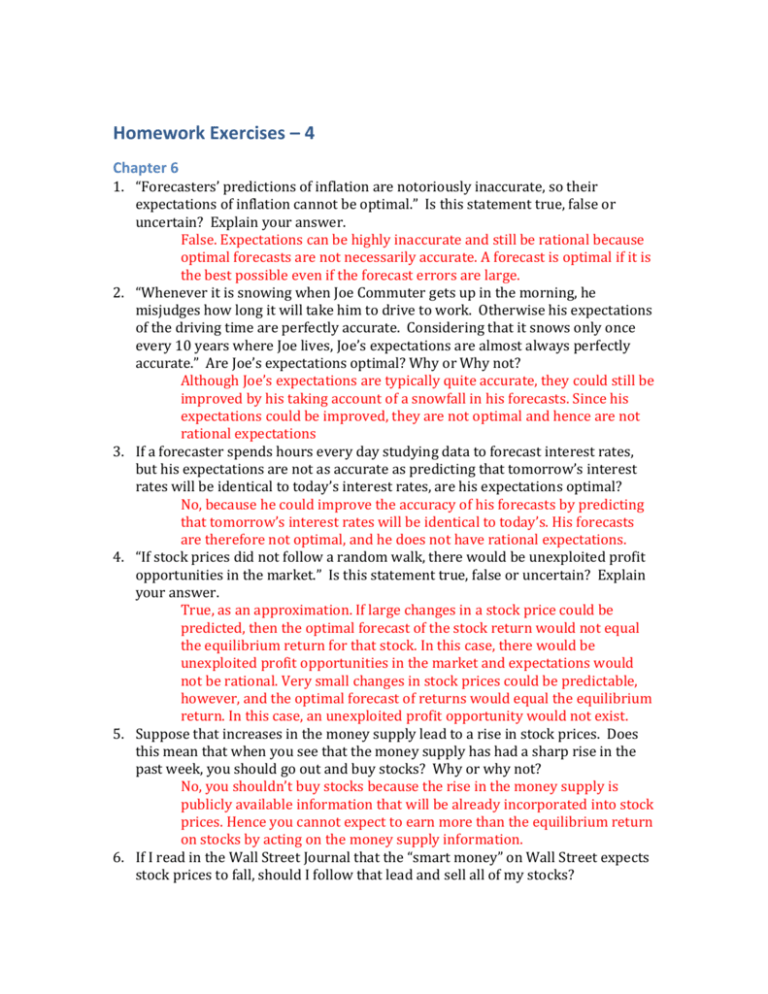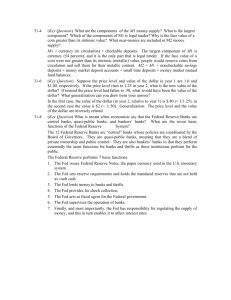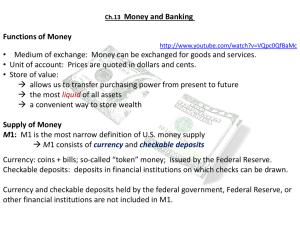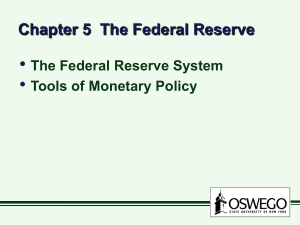Homework Answers
advertisement

Homework Exercises – 4 Chapter 6 1. “Forecasters’ predictions of inflation are notoriously inaccurate, so their expectations of inflation cannot be optimal.” Is this statement true, false or uncertain? Explain your answer. False. Expectations can be highly inaccurate and still be rational because optimal forecasts are not necessarily accurate. A forecast is optimal if it is the best possible even if the forecast errors are large. 2. “Whenever it is snowing when Joe Commuter gets up in the morning, he misjudges how long it will take him to drive to work. Otherwise his expectations of the driving time are perfectly accurate. Considering that it snows only once every 10 years where Joe lives, Joe’s expectations are almost always perfectly accurate.” Are Joe’s expectations optimal? Why or Why not? Although Joe’s expectations are typically quite accurate, they could still be improved by his taking account of a snowfall in his forecasts. Since his expectations could be improved, they are not optimal and hence are not rational expectations 3. If a forecaster spends hours every day studying data to forecast interest rates, but his expectations are not as accurate as predicting that tomorrow’s interest rates will be identical to today’s interest rates, are his expectations optimal? No, because he could improve the accuracy of his forecasts by predicting that tomorrow’s interest rates will be identical to today’s. His forecasts are therefore not optimal, and he does not have rational expectations. 4. “If stock prices did not follow a random walk, there would be unexploited profit opportunities in the market.” Is this statement true, false or uncertain? Explain your answer. True, as an approximation. If large changes in a stock price could be predicted, then the optimal forecast of the stock return would not equal the equilibrium return for that stock. In this case, there would be unexploited profit opportunities in the market and expectations would not be rational. Very small changes in stock prices could be predictable, however, and the optimal forecast of returns would equal the equilibrium return. In this case, an unexploited profit opportunity would not exist. 5. Suppose that increases in the money supply lead to a rise in stock prices. Does this mean that when you see that the money supply has had a sharp rise in the past week, you should go out and buy stocks? Why or why not? No, you shouldn’t buy stocks because the rise in the money supply is publicly available information that will be already incorporated into stock prices. Hence you cannot expect to earn more than the equilibrium return on stocks by acting on the money supply information. 6. If I read in the Wall Street Journal that the “smart money” on Wall Street expects stock prices to fall, should I follow that lead and sell all of my stocks? No, because this is publicly available information and is already reflected in stock prices. The optimal forecast of stock returns will equal the equilibrium return, so there is no benefit from selling your stocks. 7. If my broker has been right in her five previous buy and sell recommendations, should I continue listening to her advice? Probably not. Although your broker has done well in the past, efficient markets theory suggests that she has probably been lucky. Unless you believe that your broker has better information than the rest of the market, efficient markets theory indicates that you cannot expect the broker to beat the market in the future. 8. Can a person with optimal expectations expect the price of Google to rise by 10% in the next month? No, if the person has no better information than the rest of the market. An expected price rise of 10% over the next month implies over a 100% annual return on IBM stock, which certainly exceeds its equilibrium return. This would mean that there is an unexploited profit opportunity in the market, which would have been eliminated in an efficient market. The only time that the person’s expectations could be rational is if the person had information unavailable to the market that allowed him or her to beat the market. 9. “If most participants in the stock market do not follow what is happening to the monetary aggregates, prices of common stocks will not fully reflect information about them.” Is this statement true, false or uncertain? Explain your answer. False. All that is required for the market to be efficient so that prices reflect information on the monetary aggregates is that some market participants eliminate unexploited profit opportunities. Not everyone in a market has to be knowledgeable for the market to be efficient. 10. “An efficient market is one in which no one every profits from having better information than the rest.” Is this statement true, false or uncertain? Explain your answer. False. The people with better information are exactly those who make the market more efficient by eliminating unexploited profit opportunities. These people can profit from their better information. Note, if the market is completely efficient then these profit opportunities would not exist. 11. If higher money growth is associated with higher future inflation and if announced money growth turns out to be extremely high but is still less than what the market expected, what do you think would happen to long term bond prices? Because inflation is less than expected, expectations of future short-term interest rates would be lowered, and as we learned in Chapter 7, longterm interest rates would fall. The decline in long-term interest rates implies that long-term bond prices would rise. 12. “Foreign exchange rates, like stock prices, should follow a random walk.” Is this statement true, false or uncertain. Explain your answer. (from Mishkin)True in principle. Foreign exchange rates are a random walk over a short interval such as a week because changes in the exchange rate are unpredictable. If a change were predictable, large unexploited profit opportunities would exist in the foreign exchange market. If the foreign exchange market is efficient, these unexploited profit opportunities cannot exist, and so the foreign exchange rate will approximately follow a random walk. My view would be that the FX market may exhibit inefficiencies that can be exploited. In certain circumstances there may be an external agent (a central bank) that has a stated goal for the currency (for example to maintain a peg against the dollar). In this situation you may be able to exploit real profit opportuniites. 13. Can we expect the value of the dollar to rise be 2% next week if our expectations are optimal? No, because this expected change in the value of the dollar would imply that there is a huge unexploited profit opportunity (over a 100% expected return at an annual rate). Since the rational expectations theory rules out unexploited profit opportunities, such a big expected change in the exchange rate could not exist. 14. “Human fear is the source of stock market crashes, so these crashes indicate that expectations in the stock market cannot be optimal.” Is this statement true, false or uncertain? Explain your answer. False. Although human fear may be the source of stock market crashes, that does not imply that there are unexploited profit opportunities in the market. Nothing in rational expectations theory rules out large changes in stock prices as a result of fears on the part of the investing public. Chapter 6 - Quantitative Questions 1. A company has just announced a 3-for-1 stock split, effective immediately. Prior to the split, the company had a market value of $5 billion with 100 million shares outstanding. Assuming that the split conveys no new information about the company, what is the value of the company, the number of shares outstanding, and price per share after the split? If the actual market price immediately following the split is $17.00/share, what does this tell us about market efficiency? Prior to the split, each share was worth $5 billion/100 million, or $50/share. If the split conveys no new information, the market value of the company does not change, remaining at $5 billion. But, with the split, every share becomes three shares, so 300 million shares are outstanding. The new price/share is $5 billion/300 million, or $16.67/share. If the actual price is $17.00/share, the price appears too high. This can be viewed two ways. One possibility is that markets are inefficient—some type of anomaly has occurred, and it’s not clear if the market will correct itself. Another possibility is that the stock split actually conveyed information about the company. Investors may believe (possibly incorrectly) that the price/share is expected to increase significantly, and that is why the firm implemented the stock split. 2. If the public expects a corporation to lose $5 a share this quarter and it actually loses $4, which is still the largest loss in the history of the company, what does the efficient market hypothesis say will happen to the price of the stock when the $4 loss is announced? The stock price will rise. Even though the company is suffering a loss, the price of the stock reflects an even larger expected loss. When the loss is less than expected, efficient markets theory then indicates that the stock price will rise. Chapter 6 – Additional Questions 1. Explain the difference between pure and statistical arbitrage? Pure arbitrage is a profit opportunity that is guaranteed to make money. A statistical arbitrage will make money more than 50% of the time but not 100% of the time. 2. If you knew that the EUR was going to strengthen 1% versus the pound next week describe two ways in which you could take advantage of this arbitrage. Be specific – as in you will make 1% profit by executing the following trades. You would want to own EUR for the week. In order to own EUR you would want to borrow GBP, exchange GBP into EUR today and lend EUR for 1 week. At the end of the week you would receive EUR from the counterparty that you lent to, exchange the EUR back into GBP and repay the borrowing. As you knew that EUR would strengthen relative to GBP the EUR you have in a week would be worth more than GBP and thus you would profit. 3. Assume the expectations theory of interest rates and that the 1-year interest rate is 3% and the 2-year interest rates is 4% and the one-year interest rate starting in one year is 2%. Describe a series of trades that arbitrage these rates. The key to understanding this is to figure out which is worth more – the interest earned over 2 years due to lending for two years or the interest earned over two years due to lending for a year and then lending for another year. In this case (1.04)^2-1 > 1.03*1.02-1. Thus if you borrow money for one year and then another and lend it for two years you will end up with a profit of (1.04)^2-1 – (1.03*1.02-1) = 1.04^2-1.03*1.02. 4. What was the paradox that Stiglitz pointed out in 1980 regarding the efficient markets hypothesis? The paradox that Stiglitz pointed out was that in order for market participants to expend resources to make markets efficient there must be some inefficiency. If there were no inefficiency then there would be no incentive to try to exploit profit opportunities. 5. A standard way of looking at the efficient markets hypothesis is to suppose there are two types of investors – smart investors and noise investors. a. What types of investors do these describe? Smart investors use information in the market to inform their decisions. They understand the how that information affects market prices. Noise investors either invest randomly or often invest after information has already affected the market. b. The assumption is that smart investors will profit from uninformed noise investors. Describe why this might not be true in practice. This might not be true because there may be many more noise investors than smart investors and the smart investor may be correct but not have enough money to bring the market to equilibrium. Chapter 9 – Questions 1. Why was the Federal Reserve System set up with 12 regional Federal Reserve banks rather than one central bank, as in other countries? Because of traditional American hostility to a central bank and centralized authority, the system of 12 regional banks was set up to diffuse power along regional lines. 2. What political realities might explain why the Federal Reserve Act of 1913 placed two Federal Reserve banks in Missouri? The placement of two banks in the Midwest farm belt might have been engineered to placate farmers, an important voting block in the early twentieth century. Alternatively Senator James A. Reed was rewarded by the Senate for breaking a deadlock in committee and permitting the 1913 law to pass. Kansas City, of which he was formerly mayor, was awarded a bank, and St. Louis, one of America’s great commercial hubs at the time, got one too 3. “The Federal Reserve System resembles the US Constitution in that it was designed with many checks and balances.” Discuss. Like the U.S. Constitution, the Federal Reserve System, originally established by the Federal Reserve Act, has many checks and balances and is a peculiarly American institution. The ability of the 12 regional banks to affect discount policy was viewed as a check on the centralized power of the Board of Governors, just as states’ rights are a check on the centralized power of the federal government. The provision that there be three types of directors (A, B, and C) representing different groups (professional bankers, businesspeople, and the public) was again intended to prevent any group from dominating the Fed. The Fed’s independence of the federal government and the setting up of the Federal Reserve banks as incorporated institutions were further intended to restrict government power over the banking industry. 4. In what ways can the regional Federal Reserve banks influence the conduct of monetary policy? The Federal Reserve Banks influence the conduct of monetary policy through their administration of the discount facilities at each bank and by having five of their presidents sit on the FOMC, the main policymaking arm of the Fed. 5. Which entities in the Federal Reserve System controls the discount rate? Reserve Requirements? Open market operations? The Board of Governors sets reserve requirements and the discount rate; the FOMC directs open market operations. In practice, however, the FOMC helps make decisions about reserve requirements and the discount rate. 6. Do you think that the 14-year non-renewable terms for governors effectively insulates the Board of Governors from political pressure? The 14-year terms do not completely insulate the governors from political influence. The governors know that their bureaucratic power can be reined in by congressional legislation and so must still curry favor with both Congress and the President. Moreover, in order to gain additional power to regulate the financial system, the governors need the support of Congress and the President to pass favorable legislation. In addition the governors do not often stay in their position for their entire 14 year term. This can lead to a president appointing more governors than would otherwise be expected. 7. Compare the structure and independence of the Federal Reserve System and the European System of Central Banks. The Federal Reserve and European System of Central Banks have a similar structure in that there is an equivalence between the Board of Governors (Fed) and the Executive Board (ECB) and then the FOMC (Fed) and the Governing Council (ECB). A key difference between the latter two bodies is that the FOMC has a majority of members as political appointments whereas the Governing Council has as a majority the heads of central banks. The ECB has a similar structure regarding independence. Both have instrument independence and have their high level goals set through legislation/treaty. The ECB might be considered to be more independent as all countries in the European community have to ratify changes to its charter whereas the Fed is subject to Congressional changes. 8. The Fed is the most independent of all U.S. Government agencies. What is the main difference between it and other government agencies that explains the Fed’s greater independence? The Fed is more independent because its substantial revenue from securities and discount loans allows it to control its own budget. 9. What is the primary tool that Congress uses to exercise some control over the Fed? The threat that Congress will acquire greater control over the Fed’s finances and budget or the threat that Congress will change its charter. 10. In the 1960’s and 1970’s the Federal Reserve System lost member banks at a rapid rate. How can the theory of bureaucratic behavior explain the Fed’s campaign for legislation to require all commercial banks to become members? Was the Fed successful in this campaign? The theory of bureaucratic behavior indicates that the Fed will want to acquire as much power as possible by requiring all banks to become members. Although the Fed did not succeed in obtaining legislation requiring all banks to become members of the system, it was successful in getting Congress to legislate extension of many of the regulations that were previously imposed solely on member banks (for instance, reserve requirements) to all other depository institutions. Thus the Fed was successful in extending its power. 11. “The theory of bureaucratic behavior indicates that the Fed never operates in the public interest.” Is this statement true, false or uncertain? Explain your answer. False. Maximizing one’s welfare does not rule out altruism. Operating in the public interest is clearly one objective of the Fed. The theory of bureaucratic behavior only points out that other objectives, such as maximizing power, also influence Fed decision making. 12. Why might eliminating the Fed’s independence lead to a more pronounced political business cycle? Eliminating the Fed’s independence might make it more shortsighted and subject to political influence. Thus, when political gains could be achieved by expansionary policy before an election, the Fed might be more likely to engage in this activity. As a result, more pronounced political business cycles might result. 13. “The independence of the Fed leaves it completely unaccountable for its actions.” Is this statement true, false or uncertain? Explain your answer. False. The Fed is still subject to political pressure because Congress can pass legislation limiting the Fed’s power. If the Fed is performing badly, Congress can therefore make the Fed accountable by passing legislation that the Fed does not like. 14. “The independence of the Fed has meant that it takes the long view and not the short view.” Is this statement true, false or uncertain? Explain your answer. Uncertain. Although independence may help the Fed take the long view, because its personnel are not directly affected by the outcome of the next election, the Fed can still be influenced by political pressure. In addition, the lack of Fed accountability because of its independence may make the Fed more irresponsible. Thus it is not absolutely clear that the Fed is more far sighted as a result of its independence. 15. The Fed promotes secrecy by not releasing the minutes of the FOMC to Congress or the public immediately. Discuss the pros and cons of this policy. The argument for not releasing the FOMC directives immediately is that it keeps Congress off the Fed’s back, thus enabling the Fed to pursue an independent monetary policy that is less subject to inflation and political business cycles. The argument for releasing the directive immediately is that it would make the Fed more accountable. Chapter 9 – Additional Questions 1. The Federal Reserve is the third central bank of the United States. Name two reasons why the first two banks did not get re-chartered? 2. 3. 4. 5. 6. 7. The constitutionality of the central bank was not yet accepted at the time of recharter. The first two central banks were commercial as well as central banks. This made them unpopular with other banks. A restrictive monetary policy in a growing economy made the central banks unpopular with the public. The Second Central Bank of the United States carried out an early version of open market operations in the 1820’s. Describe how this worked. The central bank would receive bank notes issued by regional banks. If they thought that the bank was overleveraged (too loose a monetary policy) they would convert the banknotes into gold thus reducing the bank notes in circulation and reducing the gold reserves of the bank. Describe what is meant by Instrument Independence and Goal Independence of central banks? Prior to 1997 the Bank of England had neither of these. After 1997 the government of the UK granted the Bank of England which of these? Why? Instrument independence refers to the freedom of the central bank to use the tools of monetary policy. Goal independence is the freedom of the central bank to set the goals of monetary policy. The Bank of England was granted instrument independence in part to keep borrowing costs lower under a Labour government. The Labour party was considered to be softer on inflation than the preceeding Conservative government. Prior to 1863 paper money was issued by which financial institutions? What changed in 1863? Prior to 1863 paper money was issued by state chartered Banks. In 1863 banks could take on a national charter and in exchange would issue national bank notes. This created a uniform national currency. Describe some of the advantages of a uniform national currency. It allows for the free exchange of money across regionals. A dollar issued by a New England bank might now be accepted in Ohio as there was little information about the bank in the region. This would in term promote commerce across states and regions. The Federal Reserve Act of 1913 created the Federal Reserve. Describe two ways in which this act tried to avoid some of the problems with the first two central banks. The bank was not a commercial bank and thus not in competition with other banks. The bank was organized as 12 regional reserve banks that tried to decentralize the power of the bank. There was a fear of a concentration of power in either Washington or NY. Explain the difference between the Board of Governors of the Federal Reserve and the Federal Open Markets Committee? The Board of Governors includes 7 political appointees for a period of 14 years. Along with 5 reserve bank presidents this makes up the FOMC. The Board of Governors sets (within limits) the reserve requirements and the discount rate. The FOMC directs open market operations and advises on reserve requirements and the discount rate. 8. Name three things that the Glass-Steagall act of 1933 achieved. a. Created the Federal Deposit Insurance Corporation (FDIC) b. Separated commercial and investment banking c. Prohibited Investment Banks from taking deposits d. Gave the Fed the power to set maximum interest rates on time deposits e. Created the FOMC








